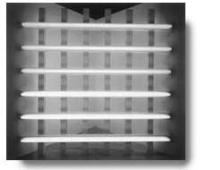Obituaries: Dan Flavin, 63

Dan Flavin, whose radical fluorescent light sculptures are familiar to museum-goers worldwide, died at Central Suffolk Hospital on Friday of complications from diabetes. The artist, who lived on Beach Lane in Wainscott, was 63.
His minimalist works - he was perhaps the first artist to construct sculptures using electric light - arose from his Abstract Expressionist background, using simple construction, large scale, and saturated color.
While Mr. Flavin's work has mainly been exhibited in major museums and galleries, since 1983 East Enders have had a chance to see it on permanent display in Bridgehampton, at the branch of the Dia Art Foundation on Corwith Avenue. The gallery, a former firehouse and originally known as the Dan Flavin Art Institute, is open during the summer and mounts other exhibits in addition to Mr. Flavin's work.
It is an institution that has had its shares of ups and downs and personality conflicts, given Mr. Flavin's somewhat litigious nature, but also, thanks to Dia's resources, mounted many exhibits of a specificity and range beyond the reach of many East End galleries.
The critic John Russell, writing in 1985, enthused both over this little-known gallery and over Mr. Flavin's work. "The fluorescent light has a soft enveloping glow, quite unlike the needley, pinched aggressive quality of neon . . . but there is no sentimentality, either. Flavin uses candy colors, but he leaves out the sugar substitute. . . . The pieces have no corporeal substance. Switched off, they are as inert as a broken phonograph. Switched on, they lead a charmed life, doubling back and forth between dream and reality. . . . In its radiant, uncombative way, his institute has a unique experience to offer."
While his art may not have been combative, Mr. Flavin himself was more so. He was described by some who knew him as both irascibly brilliant and tediously labyrinthine. But all agreed with Annie Solomon, speaking from Florida, who said he was always warmly generous in defense of other artists whom he admired - not just other minimalists like Donald Judd, but those whose work was far removed from his, like James Brooks and Syd Solomon.
He regularly fired off letters to The Star - trashing lectures by Tom Wolfe and Kirk Varnedoe, George Bush's presidential campaign, the lack of parking on Beach Lane, Henry Geldzahler's curatorship of the Bridgehampton Dia, and, memorably, questioning the artistic merit of certain prominent local artists. This last, as did many of his letters, engendered a barrage of spluttering, irate replies - which was possibly why he wrote them in the first place.
Daniel Nicholas Flavin was born on April 1, 1933, in New York City, a twin son of Daniel N. Flavin and the former Viola Bernzott. He grew up in Queens, where he attended a seminary before moving on to study art history at the New School for Social Research and Columbia University. During the Korean War he served with the Air Weather Service of the U.S. Air Force.
After supporting his art by working as a guard at the Museum of Natural History and the Museum of Modern Art and as a messenger for the Guggenheim Museum, he had his first exhibit in 1961, at the Judson Gallery in Greenwich Village. Mr. Flavin first showed his light sculptures at the Green Gallery on 57th Street three years later and was with the Leo Castelli Gallery for many years before moving to the Pace Gallery.
His 1961 marriage to Sonia Severdija ended in divorce. He was married in 1992 to Tracy Harris, who survives him, in a dramatic ceremony in the rotunda of the Guggenheim, which was mounting its second major exhibit of his work at the time.
In addition to his wife, Mr. Flavin leaves a son, Stephen Conor Flavin. His twin brother died in 1962.
A private service will be held on Dec. 12, with burial in Wainscott Cemetery.
Memorial contributions have been suggested for the American Diabetes Foundation.
